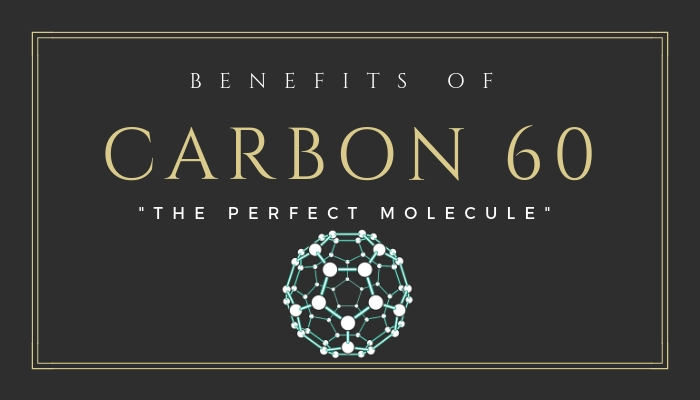What is C60?
C60 fullerene oil, or buckminsterfullerene, refers to an allotrope molecule of carbon. Initially discovered in 1980 by Japanese physicist Sumio Iijima, C60 was the first carbon fullerene discovered outside of the commonly known graphite, graphene, diamond, and charcoal carbon allotropes. Colloquially known as “buckyballs,” buckministerfullerene molecules are identifiable under an electron microscope by their spherical shapes, which are said to resemble the balls used in European football (North American soccer). Specifically, a C60 molecule takes the shape of a truncated icosahedron, which is composed of twelve pentagonal faces, twenty hexagonal faces, sixty vertices, and ninety edges.
While Iijima identified C60 in nature five years prior, in 1985 astrophysicists Harold Kroto (of Sussex University), James Heath, Sean O’Brien, Richard Smalley, and Robert Curl were able to synthetically manufacture the molecule in the laboratories of Rice University. In the years that followed, fullerenes in general were put through extensive research and evaluation based on their hypothesized applications in nanotechnology, materials science, and biomedical science. Mass spectrometry evidence has indicated that “buckyballs” can be isolated from ordinary organic matter such as soot, and is naturally occurring in deep space. C60 is highly reactive and can act as a chemical catalyst, a chemical sensor, a polymer additive, a superconductor, and a container for hydrogen atoms (meaning they may be more effective than metal hydrides in fuel cells). In terms of human health, when prepared correctly C60 can act as an extraordinarily effective lubricant and antioxidant, and may be a promising drug delivery system by which certain pharmaceuticals and cancer therapies can be more efficiently synthesized in the human body.

C60 Benefits and Uses
Longevity
In a 2012 study published by Biomaterials, researchers examined the biomedical potential of C60 oil in a laboratory mouse model. They found that oral administration of C60 dissolved in olive oil (at a dose of 1.7 mg/kg of animal body weight) nearly doubled the lifespan of treated rats without inducing genomic toxicity. Researchers hypothesized that the lifespan-promoting effects of the C60-olive oil solution lay in its intracellular ability to attenuate age-related oxidative stress.
Researchers have further theorized that C60 fullerene may be possessed of anti-aging compounds such as lipophilic cations and other mitochondrial-targeted antioxidants that contribute to its lifespan-promoting mechanism. However, further in vitro and in vivo trials are necessary to confirm and elucidate the specifics of this ability. To date, the aforementioned study is the only peer-reviewed piece to specifically address C60 fullerene’s potential lifespan-promoting ability.
Antioxidant
C60 fullerene has a well-researched and documented antioxidant capability. In a scientific review published by Biomedical Research International, researchers postulated that buckminsterfullerene’s antioxidant mechanisms are based on both high radical scavenging activities and the systematic uncoupling of respiration and phosphorylation activities. Via DFT (Discrete Fourier transform) simulation, they were able to discern that C60 travels between the inner and outer membranes of mitochondria, ultimately acquiring a positive charge and reducing the intensity of superoxide anion-radical production. This activity results in charge-loaded “cleaning” in subcellular compartments, possibly contributing to its highly effective antioxidant action in eukaryotic cells.
Overall, C60 fullerene is often characterized by researchers as a “free radical sponge,” an entity with an antioxidant efficacy that exceeds its conventional antioxidant counterparts by several hundred-fold. This activity has been verified in vivo. In a 2010 clinical trial published by Toxicology Mechanisms and Methods, researchers assessed the efficacy of C60 fullerene nanoparticles against doxorubicin-induced toxicity in rat kidneys, testes, and lungs. Results yielded that doxorubicin (a common chemotherapy treatment) produced a statistically significant increase in lipid peroxidation and alterations in antioxidant enzymatic activity. The C60 treatment exerted a protective role in terms of lipid peroxidation and the antioxidant activities of enzymes dismutase, catalase, glutathione-peroxidase, -reductase, and –transferase. Further investigation indicated that C60 fullerene treatment removed free iron in cells and thus attenuated doxorubicin toxicity.
Both in vivo and in vitro research has indicated that C60 has a somewhat unique and multi-faceted antioxidant and possibly radioprotective effect. In a 2009 publication of Free Radical Biology and Medicine, researchers examined the protective abilities of aqueous C60 solutions against ionizing radiation in vitro. It was confirmed that C60 fullerene exerted an antioxidant mechanism via the scavenging of hydroxyl radicals. Additionally, the compound was shown to protect nucleic acids against oxidative damage, ostensibly by reducing X-ray-generated reactive oxygen species (ROS). These results were later observed with laboratory mice that were exposed to radiation and administered an oral dosage of C60HyFn in vivo. These data indicate that C60 is both an antioxidant agent and a potential radioprotective molecule when synthesized carefully.

Hair Growth
Fullerenes in general have been pinpointed as potential beneficial ingredients in cosmetics and hair-health products. Some science supports the theory that C60 enhances the strength of human hair fibers. In a 2006 study published by Applied Surface Science, researchers compared C60+ and Ga+ (positive gallium ions) in the enhancement of hair fibers in vitro. While at first data for the two ions appeared to be on a similar positive spectrum, further investigation yielded that C60+ produced a positive enhancement factor at silicone and cationic conditioner peaks that exceeded Ga+ by two and three orders of magnitude.
Some have theorized that C60 may have the capacity to be an effective hair-protective agent based on its purported anti-aging properties as well as its protective capabilities against chemotherapy-induced detrimental effects (possibly including hair loss). However, peer-reviewed, placebo-controlled clinical research is very limited in this regard.
Cancer
In recent years, scientists have explored nanotechnology and its applications in novel cancer therapies. Buckminsterfullerene has emerged as a potential therapeutic in the field of cancer diagnosis and treatment. A 1994 study published by Chinese Physics Letters observed the biological impact of a water-soluble C60 liposome on human cervix cancer cells. Results indicated a significant inhibitory affect on cervix cancer cells when irradiated with C60.
A 2008 study published by Biomaterials further elucidated the molecule’s possible anti-cancer mechanism. Researchers administered a preparation of C60 fullerene (at doses of 25, 50, and 100 mg/kg per week for three weeks) to male Wistar rats with doxorubicin-induced toxicity as well as colorectal cancer. After results were investigated on macroscopic, microscopic, hematological, biochemical, physiological, pharmacological, and pharmacokinetic parameters, researchers concluded that C60 exerted a protective effect on the liver and tissue against chemotherapy-induced chronic toxicity. However, its ameliorative effects against colorectal cancer cells were not significant.
There is some concern that C60 fullerene may yield considerable toxicity toward normal cells, which lends some confusion towards its anti-cancer potential. A 2009 study also published by Biomaterials observed the ability of C60 to suppress tumor cell growth in vitro and in vivo. In the initial stages of the study, researchers observed that C60 induced apoptotic and necrotic cell death in B16 melanoma cells in a laboratory mouse model. However, after two weeks, researchers also observed that C60 actually began to augment tumor growth after intraperitoneal administration in an in vitro study. This demonstrates a significant difference between C60’s anticancer activity on an intracellular level and its capacity to potentiate tumor growth.
To sum, C60’s anti-cancer and chemoprotective capabilities appear to be complex and situation-dependent. For this reason, much more research is necessary before C60 fullerene can be considered a safe and effective adjunct cancer treatment.
Multiple sclerosis
Multiple sclerosis is a disease affecting the central nervous system, in which the immune system mistakenly attacks the protective myelin sheath that covers nerve fibers. This results in nerve scarring that inhibits effective signaling between the brain and body. Symptoms may include vision loss, chronic pain, impaired coordination, and chronic fatigue. While there is no cure for multiple sclerosis (MS) to date, research has indicated a strong need for effective antioxidant therapies in combating the oxidative stress associated with the disease. Some researchers have theorized that C60 may be an effective treatment for MS based on its antioxidant potency. Multiple sclerosis is also associated with free radical toxicity, a quality that may be ameliorated by C60’s mechanism of action. However, to date there have been no clinical trials proving or disproving buckminsterfullerene’s efficacy in treating multiple sclerosis.

Reminder: Make sure to check for C60’s side effects and toxicity before intake. Consult your doctor.
Anti-Inflammatory
In addition to being a powerful antioxidant, C60 fullerene has demonstrated anti-inflammatory activities. A 2016 study published by the Journal of Nanobiotechnology observed the therapeutic effects of a water-soluble form of fullerene C60 in ROS (reactive oxygen species)-dependent inflammation. A C60 solution was administered subcutaneously and epicutaneously to mice suffering from atopic dermatitis. Results indicated that C60 was able to restore functionality of the skin barrier, shifting immune response from Th2 cytokine production to increased Th1 cytokine production.
A study published by Basic & Clinical Pharmacology & Toxicology yielded similar results. Researchers examined the therapeutic effects of a saline solution of C60 in mice with neutrophilic lung inflammation induced by quartz. Results indicated that, via free radical scavenging, C60 was able to attenuate neutrophilic lung inflammation and neutralize the pro-inflammatory actions of quartz-induced ROS.
Skin
A 2010 study published by the Journal of Nanoscience and Nanotechnology evaluated a highly purified and organic-solvent-free treatment of C60 fullerene and its capabilities as a cosmetic antioxidant. The study was conducted with twenty-three Japanese women in their thirties; they were enrolled in an eight-week trial assessing the anti-wrinkle efficacy of LF-SQ (squalane-dissolved C60 fullerene) in which the blended cream was applied twice daily on one side of the face. Researchers evaluated the following parameters: trans-epidermal water loss (TEWL), moisture levels of the stratum corneum, and visco-elasticity of the cheeks. Conclusions yielded that LF-SQ was not effective by the fourth week, but began to produce results by the 8th week. Specifically, the LF-SQ preparation reduced skin roughness by a statistically significant margin (p<0.05).
C60 fullerene is often referred to as a “radical sponge” in terms of its relationship with the skin. While C60 fullerene has been the subject of intensive research in the cosmetic industry over the past few years, some researchers have also demonstrated interest in its free radical scavenging activity in relationship to melanogenesis in human skin cells. A 2006 study published by Fullerenes, Nanotubes and Carbon Nanostructures evaluated the inhibitory effect of water-soluble C60 on UV-induced apopotosis-like cell death against HaCaT cells. Researchers observed that the water-soluble fullerene treatment inhibited cell death and attenuated melanogenesis in human skin cells without any observable cytotoxicity. This information indicates that C60 fullerene may have anti-melanoma activities as well as skin-lightening properties. However, a safety evaluation of C60 fullerene and its impacts on the human dermis has yet to be conducted.
Diabetes
Some researchers have proposed the use of C60 in the treatment of diabetes mellitus and its complications based on the allotrope’s action on oxidative stress. In a 2012 study conducted by the Palladin Institute of Biochemistry of the National Academy of Sciences of Ukraine (NASU) in Kiev, researchers assessed the antioxidant effects of hydrated C60 fullerene (C60HyFn) in the brains and livers of male Wistar rats with streptozotocin-induced hyperglycemia (streptozotocin also induced oxidative damage in the lipids and proteins of the rats’ central nervous system and liver). Researchers found that therapeutically-administered C60 fullerene restored gilial fibrillary acidic proteins to their normal levels by lowering astrogliosis (a destructive increase of astrocytes due to trauma or infection) caused by hyperglycemia. However, they also observed that C60 did not remediate blood glucose levels in diabetic rats and therefore did not attenuate the primary causal factor of metabolic disturbance.
Another study published by Toxicology explored diabetes mellitus as it relates to male sexual dysfunction and the ability of hydrated C60 fullerene in eliminating hyperglycemia-induced testicular dysfunction in male Wistar rats. Rats received an aqueous treatment of C60 at a dose of 4μg/kg daily for five weeks after hyperglycemia was induced with streptozotocin. Researchers found that levels of serum testosterone, testicular-reduced glutathione, and alpha-tocopherol were significantly reduced under STZ-induced diabetes, but that C60 had a significant corrective effect on these parameters.
Though results of these and other studies are not definitively conclusive, there is some clinical evidence to indicate that C60 may play a measured role in reducing diabetes-induced oxidative stress and complications of diabetes mellitus. However, it is unlikely that C60 fullerene treatment is able to ameliorate the cause of hyperglycemic diabetes.
Weight Loss
Buckminsterfullerene oil’s protective action against reactive oxygen species (ROS) has led many researchers to hypothesize that it may yield a weight management effect, based on the assumption that reactive oxygen species play a key factor in the development of obesity. A study published by Molecular and Cellular Biochemistry examined intracellular lipid accumulation in a laboratory mouse model and observed buckminsterfullerene’s ability to suppress this process. Researchers found that polyhydroxylated fullerene C60 suppressed lipid accumulation and subsequent PPARγ2 expression, ultimately decreasing the spontaneous differentiation of preadipocytes into adipocytes (or fat storage cells).
A 2010 study published by Biomaterials yielded similar results. Researchers explored the effects of squalane-dissolved fullerene C60 on adipose conversion in inflammatory adipose-tissue and stromal preadipocyte-U937 lymphoma cell cultures. They found that squalane-dissolved fullerene C60 inhibited macrophage activation and adipogenesis in the OP9-U937 culture. Researchers concluded that squalane-C60 fullerene may have potential as a therapeutic option in the treatment of metabolic syndrome and/or obesity-related diseases.
Macular degeneration
Macular degeneration is a condition caused by the slow degradation of the eye’s central retina, and is the leading cause of vision loss and blindness in North America. In recent years, individuals studying the degeneration of the human eye have turned to nanotechnology as a possible regenerative therapy.
To date, no studies have pointed to C60 specifically as a therapeutic agent in the treatment of macular degeneration. However, a 2005 study published by Chemistry & Biology did observe the antimicrobial and photosensitive activity of C60 compounds against gram-positive bacteria, gram-negative bacteria, and fungi. Results pointed C60 fullerene as an effective and selective antimicrobial photosensitizer, meaning it may have a similar mechanism to medications that use photodynamic therapy to ameliorate macular degeneration (such as verteporfin, a benzoporphyrin derivative). However, more clinical evidence is needed before C60 fullerene can be considered a safe and efficacious photodynamic therapy in the treatment of retinal degeneration.
Depression
There is no clinical evidence to suggest that buckminsterfullerene or its derivatives have an antidepressant effect on patients. A 2008 study published by the Journal of Nanoscience and Nanotechnology found that, while intracerebral injection of C60 in laboratory rats did increase dopamine turnover rates in the hypothalamus and serotonin turnover rates in the hypothalamus, cerebral cortex, and hippocampus, intraperitoneal injection decreased dopamine turnover rates in the hippocampus. These data suggest that C60 fullerene cannot cross the blood-brain barrier and can only act on the central nervous system when administered intracerebrally.
More data is required to elucidate buckminsterfullerene’s exact mechanism of action in the central nervous systems of mammals.

C60 Dosage
Most individuals opt to take 1 to 3 ml per day of buckminsterfullerene olive oil. The proper dosage of C60 oil has not been clinically validated or scientifically evaluated, so this is based strictly on anecdotal information from individuals taking C60 olive oil.
C60 oil should not be situated near any heat-producing appliances. Further, refrigeration will cause the substance to congeal.
C60 Side Effects, Toxicity, Safety and Warning
While C60 has exhibited numerous beneficial effects in the laboratory and is easily absorbed into mammalian cells, it is important to remember that its permeability represents potential dangers to the cell membrane if administered incorrectly or excessively. Further, buckminsterfullerene is, in essence, a carbon allotrope, and has some similar structural properties to asbestos fibers. When dissolved in oil, C60 fullerene is believed to be relatively safe as oil affinity prevents the molecular clustering that leads to crystallization and toxicity. However, research into the toxicity of C60 oil is relatively limited, and it is recommended that interested patients consult thoroughly with a physician and be highly conscious of factors such as manufacturers and product purity. Though C60 fullerene has yielded substantial benefits in laboratory mouse models, it is important to note that these results arise under meticulously controlled conditions. Further, there have been some anecdotal reports of tumorigenesis resulting from C60 oil consumption.
Though C60 is believed to be safest in its oil form, it is vital to remember that oxidized oil is not invulnerable to toxicity. Polyphenols in oils decline very quickly in a matter of months, and this process is only accelerated by the introduction of light and oxygen. Many researchers are currently evaluating alternative vehicles for detoxifying C60 and delivering its beneficial bioactive assets to the human body. Further, there is some concern among global administrative bodies regarding the integration of C60 fullerene into ingestible food sources.
The Norwegian Scientific Committee for Food Safety, for example, determined after an analysis of existing toxicological and microbiological data that most key safety information is lacking in relationship to this supplement. The European Food Safety Authority concluded that the application of C60 fullerene to food sources could not be accurately assessed due to a lack of conclusive data.
Further research needs to be made on C60’s side effects and toxicity. However, a recent study posted in December 2020 concludes that exposure to C60 damages pulmonary and mitochondrial function. So make sure to check with your doctor before taking it
References:
https://www.sciencedirect.com/science/article/pii/S0891584909003669
https://www.sciencedirect.com/science/article/pii/S0142961212003237
https://www.ncbi.nlm.nih.gov/pubmed/21163323
https://link.springer.com/article/10.1007/s00415-004-0348-9
https://www.sciencedirect.com/science/article/pii/S014296120800865X
https://www.ncbi.nlm.nih.gov/pubmed/21137794
https://www.ncbi.nlm.nih.gov/pmc/articles/PMC4124742/
https://www.ingentaconnect.com/content/ben/biot/2011/00000005/00000002/art00001
https://perso.uclouvain.be/arnaud.delcorte/articles/simsXV/hair2006.pdf
https://onlinelibrary.wiley.com/doi/abs/10.1111/j.1742-7843.2008.00315.x
https://link.springer.com/article/10.1007/s11010-012-1297-8
https://jnanobiotechnology.biomedcentral.com/articles/10.1186/s12951-016-0159-z
https://vkm.no/download/18.d44969415d027c43cf9e92/1500474943293/732f564c58.pdf
https://www.sciencedaily.com/releases/2008/05/080527091910.htm
https://www.ncbi.nlm.nih.gov/pmc/articles/PMC2421009/
https://www.sciencedirect.com/science/article/pii/S014296121000548X
https://www.ncbi.nlm.nih.gov/pubmed/19049160
https://onlinelibrary.wiley.com/doi/full/10.1002/wnan.167
https://www.sciencedirect.com/science/article/pii/S0142961209009223





Been taking C60 for several years. Noticed superconductive properties immediately characterised as enhanced awareness. Had no idea there were some studies showing tumor growth rather than inhibition, but as there were in vitro and all the in vivo studies seem promising I am trusting the many hours of research I have done and will continue to consume it, maybe faster so as to not let it spoil! I am mainly interested in the mouse studies that say they lived 30% longer! Not sure if fullerene qualifies as a natural substance exactly?
Thanks Darcy !
Thanks for reading Gabi!
Is there any, and I mean ANY relationship to this form of carbon(C60) and graphene oxide? They are essentially the same element and the latter is highly toxic to humans.
I am questioning the same.
C60 may be a bad thing in the long run?
The issue is with quality and care in producing the product and STORING it properly.
Graphene is somethg you don’t want anywhere in your body 🙂
So, I may even stop taking this SUPER expensive C60.
My question also a concern as how long this C60 stays in the body?
Can one detox this ?
Any studies?
Hi Robert and CatManDo,
Research shows that C60 and Graphene Oxide are not related – sans the element. Upon further research, there is not much studies on C60’s bad effects. However, there is one research posted in December 2020 that concludes bad effects on pulmonary and mitochondrial function. You can see read more about it here – https://pubmed.ncbi.nlm.nih.gov/33370539 More research would need to be done
CatManDo, I have not seen studies on how long C60 stays in the body – some say 10 days, some have said a few weeks. But there is no conclusive study on it
Do let us know if you see any research on it.